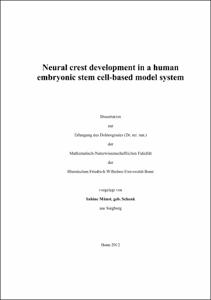Münst, Sabine: Neural crest development in a human embryonic stem cell-based model system. - Bonn, 2012. - Dissertation, Rheinische Friedrich-Wilhelms-Universität Bonn.
Online-Ausgabe in bonndoc: https://nbn-resolving.org/urn:nbn:de:hbz:5n-29633
Online-Ausgabe in bonndoc: https://nbn-resolving.org/urn:nbn:de:hbz:5n-29633
@phdthesis{handle:20.500.11811/5374,
urn: https://nbn-resolving.org/urn:nbn:de:hbz:5n-29633,
author = {{Sabine Münst}},
title = {Neural crest development in a human embryonic stem cell-based model system},
school = {Rheinische Friedrich-Wilhelms-Universität Bonn},
year = 2012,
month = sep,
note = {The neural crest is a transient embryonic cell population with outstanding characteristics. After their delamination from the closing neural tube, neural crest cells migrate extensively throughout the body and differentiate into highly diverse cell types, including peripheral neurons and glia, but also mesenchymal tissues of the head region. Neural crest development has been extensively studied in several animal models, however, the neural crest of primates, particularly of humans, remains largely inaccessible. The research on human embryonic stem (hES) cells offers a highly interesting possibility to study events of early embryonic development in an in vitro setting. In the thesis presented here, differentiating hES cells were used to study human neural crest development. Remarkably, the process of neural crest delamination is mimicked in the cell culture dish, thereby recapitulating early developmental processes. Cultivation of spontaneously differentiated embryoid bodies (EBs) in neural differentiation medium yielded prominent neural rosettes that, according to their morphology and marker expression, resembled a primitive form of the neural tube. Neural crest cells, identified by expression of the neural crest-associated markers p75NTR, HNK-1, SOXE, and AP2α, migrated from those neural tube-like structures over the fibroncetin-coated dish and formed distinct crescent-shaped aggregates at a defined distance. This process is accompanied by a characteristic cadherin switch, which is typical for an epithelial-to-mesenchymal transition, as it occurs in neural crest development in vivo. The aggregation of neural crest cells into clearly distinguishable clusters could be exploited to purify them from the heterogenous cell culture by manual picking. The level of purity, assessed by expression of p75NTR and SOXE, of the obtained cell population resembled cell populations isolated by Fluorescence Activated Cell Sorting for p75NTR (>95%). Comparison with a neural stem cell population obtained from the same parental hES cell line via microarray analysis confirmed upregulation of neural crest cell markers and distinct differences towards neural stem cells. The purified neural crest cell population could be differentiated into peripheral neurons and glia, as well as to smooth muscle cells, adipocytes, osteoblasts and chondrocytes.
The hES cell-based culture model presented here provides access to early human neural crest development and offers multiple possibilities to study the delamination, migration and differentiation of neural crest cells. Moreover, this model system provides potential for modeling of neural crest-associated diseases and pharmacology testing.},
url = {https://hdl.handle.net/20.500.11811/5374}
}
urn: https://nbn-resolving.org/urn:nbn:de:hbz:5n-29633,
author = {{Sabine Münst}},
title = {Neural crest development in a human embryonic stem cell-based model system},
school = {Rheinische Friedrich-Wilhelms-Universität Bonn},
year = 2012,
month = sep,
note = {The neural crest is a transient embryonic cell population with outstanding characteristics. After their delamination from the closing neural tube, neural crest cells migrate extensively throughout the body and differentiate into highly diverse cell types, including peripheral neurons and glia, but also mesenchymal tissues of the head region. Neural crest development has been extensively studied in several animal models, however, the neural crest of primates, particularly of humans, remains largely inaccessible. The research on human embryonic stem (hES) cells offers a highly interesting possibility to study events of early embryonic development in an in vitro setting. In the thesis presented here, differentiating hES cells were used to study human neural crest development. Remarkably, the process of neural crest delamination is mimicked in the cell culture dish, thereby recapitulating early developmental processes. Cultivation of spontaneously differentiated embryoid bodies (EBs) in neural differentiation medium yielded prominent neural rosettes that, according to their morphology and marker expression, resembled a primitive form of the neural tube. Neural crest cells, identified by expression of the neural crest-associated markers p75NTR, HNK-1, SOXE, and AP2α, migrated from those neural tube-like structures over the fibroncetin-coated dish and formed distinct crescent-shaped aggregates at a defined distance. This process is accompanied by a characteristic cadherin switch, which is typical for an epithelial-to-mesenchymal transition, as it occurs in neural crest development in vivo. The aggregation of neural crest cells into clearly distinguishable clusters could be exploited to purify them from the heterogenous cell culture by manual picking. The level of purity, assessed by expression of p75NTR and SOXE, of the obtained cell population resembled cell populations isolated by Fluorescence Activated Cell Sorting for p75NTR (>95%). Comparison with a neural stem cell population obtained from the same parental hES cell line via microarray analysis confirmed upregulation of neural crest cell markers and distinct differences towards neural stem cells. The purified neural crest cell population could be differentiated into peripheral neurons and glia, as well as to smooth muscle cells, adipocytes, osteoblasts and chondrocytes.
The hES cell-based culture model presented here provides access to early human neural crest development and offers multiple possibilities to study the delamination, migration and differentiation of neural crest cells. Moreover, this model system provides potential for modeling of neural crest-associated diseases and pharmacology testing.},
url = {https://hdl.handle.net/20.500.11811/5374}
}






